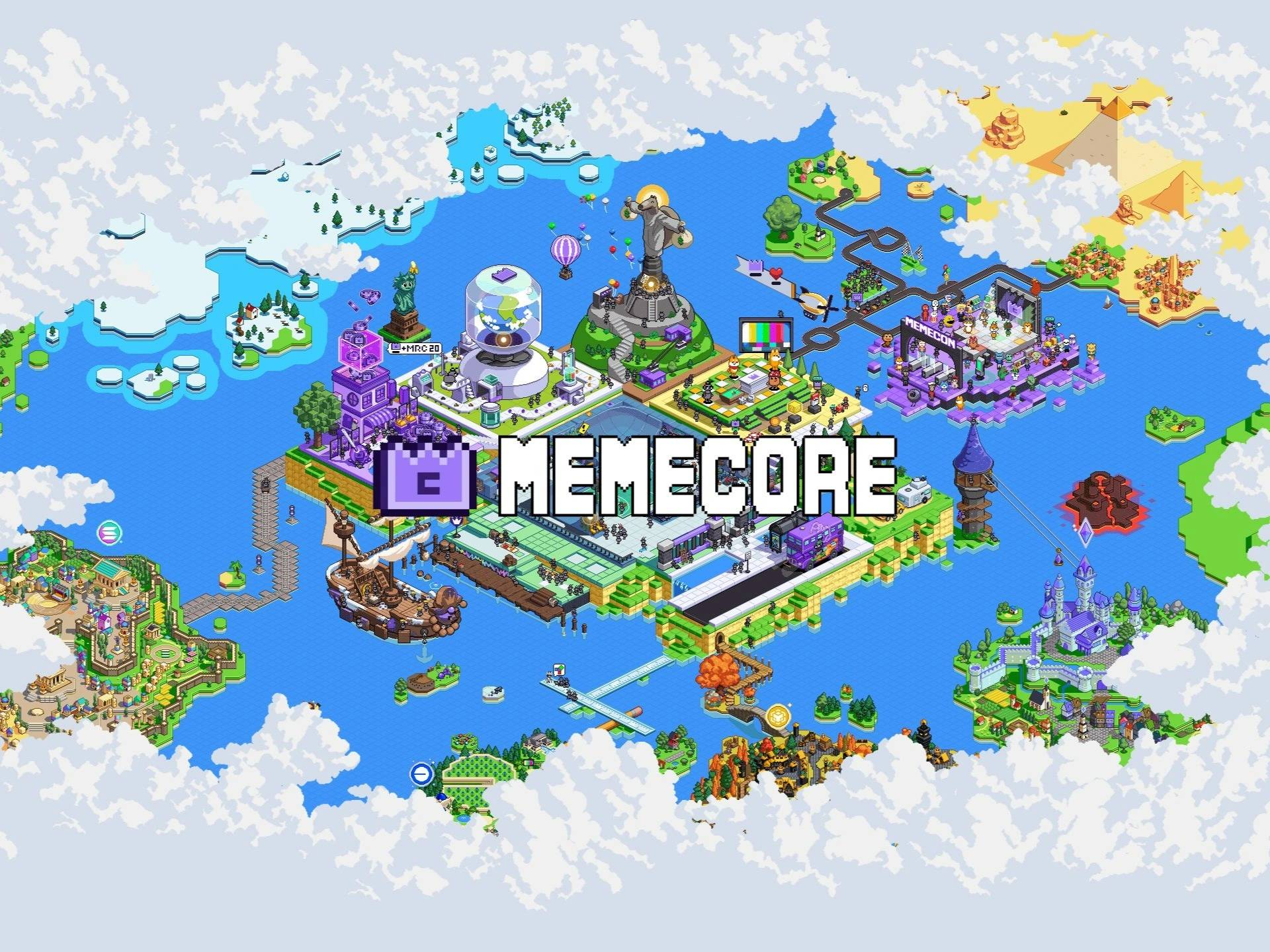订阅 wiki
Share wiki
Bookmark
Memecore
Memecore
Memecore 是一个基于区块链的游戏平台,它将模因文化与去中心化的游戏体验相结合。它的目标是创建一个生态系统,玩家可以在其中参与受模因启发的游戏,并通过各种游戏机制赚取奖励。[2]

概述
Memecore 是一个 Layer 1 区块链 网络,旨在将 Web3 领域的 meme 社区聚集在一起。它作为一个与 EVM 兼容的 主网 运行,并使用独特的 Meme 证明 (PoM) 共识机制。该系统允许用户跨 区块链 质押 meme 币,从而为网络安全做出贡献,同时赚取 $M 和 ERC-20 代币的双重奖励。
该平台强调包容性和跨链协作。它支持与 以太坊 兼容的工具和架构,从而使开发人员和用户更容易采用。Memecore 的基础设施经过专门设计,通过共享验证、质押 和激励来支持 meme 币 社区。 [1] [4]
功能特性
Meme 共识证明

Meme 共识证明 (PoM) 是 MemeCore 定制的共识机制,它融合了权益证明 (PoS) 和权威证明 (PoA) 的各个方面,旨在支持验证者治理和 meme 代币集成。该系统通过纪元(定义的时间间隔,例如一天)运行,在此期间,指定的验证者集合使用 PoA 风格的方法生成区块。在每个纪元之后,验证者集合通过治理控制的委托合约进行刷新。这种设置允许一致的区块生产和验证者轮换,旨在维持网络去中心化和效率。[6]
奖励生成
区块奖励由铸造 MemeCore 的原生代币 $M 生成,每个新区块都会进行铸造。这些代币根据公式分配给验证者和委托者,这些公式会随着时间的推移而演变,从早期阶段的固定结构到更动态的、由预言机提供信息的模型。验证者注册对外部拥有的账户 (EOA) 开放,要求用户质押指定数量的 $M 并支付注册费。最初,验证者集合上限为 100 名参与者。注册的验证者可以退出系统并收回他们的质押,尽管稍后可能会引入锁定期限。[6]
委托方法
委托机制允许EOA和合约地址通过质押 $M 或选定的meme代币来支持验证者。 Meme代币必须首先通过治理批准并添加到白名单中。委托者获得区块奖励的一部分,奖励分配受质押数量和验证者活动的影响。 存在一种削减机制,用于惩罚未能达到性能预期的验证者。 如果验证者表现不佳(由于停机或区块生产不足),他们质押的$M可能会被部分没收,并且他们可能会被排除在即将到来的验证轮次之外。
用户必须通过质押或提取代币来启动通过奖励分配合约的特定交易,以访问奖励。ERC-20 金库持有 MemeCore 上部署的每种代币总供应量的 5%,代币合约必须是开源的,并且在包含之前经过 多重签名 批准。 这些 ERC-20 代币在长期归属期内逐步释放给质押者,最初设置为 1,000 天。 治理部门保留修改此期限的权力。 PoM 结构通过灵活的委托、绩效问责制和协作治理框架来加强网络安全并激励积极参与。 [6]
验证者
MemeCore的验证者网络在Meme证明(PoM)共识下运行,优先考虑短区块时间和低交易费用。验证者根据质押资产的数量选择,质押量最高的有资格生成区块。为确保系统完整性,网络采用削减机制,例如对双重签名的惩罚,以维持安全性和稳定性。实时选举过程选择前七名验证者进行区块生产,列表每10个区块刷新一次,大约每70秒一次。候选人必须首先质押预定义的金额才有资格被选中。
MemeCore上的验证者确认交易并生成区块,直接为网络的性能和安全性做出贡献。这些节点执行维护链可靠性的重要任务。作为参与的回报,验证者会收到$M代币奖励。
验证者及其委托者都可以获得双重激励——$M代币和ERC-20代币。系统不是将整个奖励授予区块生产者,而是根据质押的数量按比例分配每个奖励(例如,每个区块1,000 $M)。这种结构支持在所有为网络做出贡献的参与者之间建立公平的奖励系统。 [7]
质押与委托

MemeCore 的质押和委托系统使代币持有者能够支持验证者并赚取奖励。验证者根据委托者质押的总金额进行排名,排名前七位的成为活跃验证者,有资格生成区块并赚取奖励。其他人则作为候选验证者,他们无法生成区块,但仍然可以接受委托以提高他们的排名。排名每 10 个区块刷新一次,确保动态和竞争性的选择过程。
委托者可以通过系统合约质押 $M 或批准的 meme 币,这些合约管理验证者选择和奖励分配。奖励在活跃验证者之间分配,其中 99% 平均分配,另外 1% 奖励给生成区块的验证者。在验证者奖励中,75% 归 $M 的委托者所有,25% 归质押 meme 币的委托者所有。验证者必须满足最低自我委托要求才能注册,委托者收到 Xtokens 作为其质押的证明,可在生态系统中使用。外部项目也可以通过使用相同公式的单独奖励合约提供 ERC-20 代币进行分配。[8]
双重奖励
MemeCore的双重奖励系统向验证者和委托者分配$M代币和ERC-20代币,以激励参与。在总区块奖励中,$M验证者及其委托者获得75%,分配基于他们质押的$M数量。验证者必须承诺固定数量(最初为700万$M)才能注册,而支持他们的委托者则向这些验证者支付其所得奖励的10%作为佣金。区块提议者的选择和奖励分享与质押水平和验证者表现相关。
Meme委托者(即质押meme币而不是$M的人)获得24%的区块奖励。这些奖励根据每个meme币的市值平均分配给每个验证者节点,并进行调整。该系统使用加权数量来平衡meme代币之间的价格差异。Meme委托者还向验证者支付15%的佣金。如果选择验证者生成区块,则额外1%的区块奖励将授予验证者及其委托者。所有奖励比例、质押要求和支持的meme代币均可通过治理进行更改。[9]
Memes.War
Memes.War 是一款基于 Telegram 的 play-to-airdrop 游戏,用户通过支持现有公会或创建自己的公会来积累 $War.Bond,并将其转换为空投积分。通过将 $War.Bond 发送到公会的金库,玩家可以帮助公会参与季节性公会突袭并获得额外奖励。$War.Bond 是游戏中的主要货币,通过各种游戏内操作获得,用于提升公会的地位和表现。一旦转移到金库,$War.Bond 将无法提取,并锁定用于突袭活动。
空投积分通过以固定汇率转换 $War.Bond 获得(10,000 $War.Bond = 10 空投积分),是确定未来空投和其他奖励分配资格的核心指标。玩家可以选择支持现有公会或组建自己的公会,获得 1,000,000 $War.Bond 的奖励,以帮助启动他们的金库。金库余额最高的公会可以获得特殊奖励,而所有参与公会都可以获得额外福利。该游戏强调社区贡献,奖励旨在表彰 MemeCore 生态系统内的个人和团体参与。需要 Telegram 才能访问和玩 Memes.War。 [10] [11]
M
$M 是 MemeCore 生态系统的原生代币,并在其运营中发挥着核心作用。它用于支付 MemeCore 主网上的交易费用。它是参与 Meme 证明 (PoM) 共识的验证者注册和委托的主要质押货币。该代币的总供应量上限为 100 亿。
除了其技术功能外,$M 在生态系统中也具有更广泛的意义。验证者必须质押 $M 才有资格进行区块生产,而委托者使用它来支持验证者排名。此外,计划在未来实施 $M 的治理功能,可能允许持有者影响网络的发展方向。[12]
代币分配
- 30% - 社区奖励和游戏激励
- 20% - 用于持续平台改进的开发基金
- 15% - 团队和顾问(受归属期限制)
- 15% - 营销和合作伙伴关系
- 10% - 流动性提供
- 10% - 战略储备 [5]
融资
2025年3月27日,MemeCore宣布已获得来自多家知名区块链风险投资公司的战略投资,包括IBC Group、Waterdrip Capital、AC Capital、CatcherVC、K300 Ventures、WAGMI Ventures和Click Capital。这些投资旨在支持MemeCore区块链基础设施的开发,扩展其生态系统,并协助孵化新兴的meme币项目。 [13]
合作伙伴
SlerfTools
Card3
Andy
AI101 Labs
ARC
Pentagon Games
发现错误了吗?
